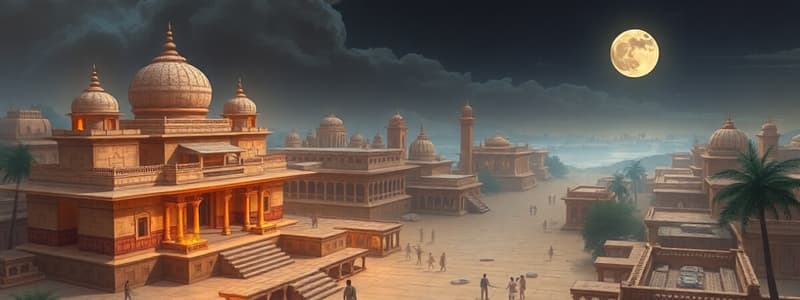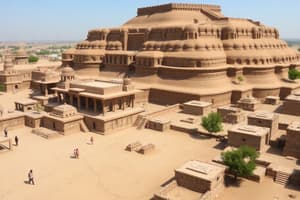Podcast
Questions and Answers
What was the geographical area encompassed by the Harappan Civilization?
What was the geographical area encompassed by the Harappan Civilization?
The Harappan Civilization flourished in the northwestern region of the Indian subcontinent, primarily in present-day Pakistan and western India.
Describe one key feature of urban planning in Harappan cities.
Describe one key feature of urban planning in Harappan cities.
Harappan cities featured a grid layout with well-planned streets and houses arranged around courtyards.
What evidence suggests the presence of a centralized authority in Harappan cities?
What evidence suggests the presence of a centralized authority in Harappan cities?
The sophisticated urban planning and standardized weights and measures suggest a possible centralized authority for planning and administration.
Which crops were primarily cultivated in the Harappan Civilization?
Which crops were primarily cultivated in the Harappan Civilization?
What role did trade play in the Harappan economy?
What role did trade play in the Harappan economy?
How does the lack of a deciphered written language affect our understanding of Harappan social structure?
How does the lack of a deciphered written language affect our understanding of Harappan social structure?
What does the discovery of large bath structures suggest about Harappan religious practices?
What does the discovery of large bath structures suggest about Harappan religious practices?
What types of crafts were produced in the Harappan Civilization?
What types of crafts were produced in the Harappan Civilization?
In what ways did the Harappan Civilization demonstrate advanced water management?
In what ways did the Harappan Civilization demonstrate advanced water management?
What can be inferred about the role of animals in Harappan society?
What can be inferred about the role of animals in Harappan society?
Flashcards
Harappan Civilization
Harappan Civilization
A sophisticated urban civilization that flourished in the northwestern region of the Indian subcontinent, encompassing present-day Pakistan and western India, from approximately 3300 to 1300 BCE. It was known for its advanced urban planning, sophisticated water management systems, and unique social structure. It was comparable to ancient Egypt and Mesopotamia in its complexity.
Harappan City Planning
Harappan City Planning
A prominent characteristic of Harappan cities was their well-designed layout with grid patterns, standardized weights and measures, and sophisticated drainage systems. This indicated a level of planning and organization that was remarkable for the time period.
Mohenjo-daro and Harappa
Mohenjo-daro and Harappa
Key cities of the Harappan Civilization, renowned for their impressive public buildings, infrastructure, and advanced drainage systems that included covered drains running through the streets to maintain sanitation.
Harappan Economy
Harappan Economy
Signup and view all the flashcards
Harappan Trade Networks
Harappan Trade Networks
Signup and view all the flashcards
Harappan Crafts
Harappan Crafts
Signup and view all the flashcards
Harappan Social Structure
Harappan Social Structure
Signup and view all the flashcards
Standardized Weights and Measures
Standardized Weights and Measures
Signup and view all the flashcards
Harappan Religion and Beliefs
Harappan Religion and Beliefs
Signup and view all the flashcards
Religious Practices in Harappa
Religious Practices in Harappa
Signup and view all the flashcards
Study Notes
Introduction to the Harappan Civilization
- The Harappan Civilization, also known as the Indus Valley Civilization, flourished in the northwestern region of the Indian subcontinent, encompassing present-day Pakistan and western India.
- Its existence spanned from approximately 3300 to 1300 BCE, exhibiting a sophisticated urban culture, comparable to those of ancient Egypt and Mesopotamia.
- Evidence suggests a unique social structure, advanced urban planning, and sophisticated water management systems.
Key Characteristics of Harappan Cities
- Urban planning was notable for its grid layouts, standardized weights and measures, and sophisticated drainage systems.
- Well-planned streets and houses with rooms, arranged around a courtyard.
- Examples of major cities include Mohenjo-daro and Harappa, showcasing impressive public buildings and infrastructure.
- These cities had sophisticated drainage systems, including covered drains running through streets, which helped maintain sanitation.
- Evidence suggests a possible centralized authority responsible for planning and administration.
Economic Aspects
- The economy relied heavily on agriculture, although trade and craft production were also significant.
- Cultivation of crops like wheat, barley, and cotton is evident.
- Extensive trade networks with Mesopotamia and other regions are suggested by archaeological finds of Indus seals and artifacts in Mesopotamia and vice-versa.
- Evidence of craft production of pottery, metalwork (bronze), and beads.
- Domestication of animals is also suggested by excavation findings and seals.
Social Structure
- No written language has been deciphered, making a detailed understanding of social hierarchy challenging.
- However, the layout of cities, sizes of houses, and distribution of artifacts suggests a stratified society with a possible ruling class and skilled artisans/workers.
- Evidence of standardized weights and measures suggests a system for economic control and trade.
Religion and Beliefs
- Limited information is available about religious practices.
- Figurines and seals suggest possible religious importance of animals and deities.
- The presence of large bath structures in Mohenjo-daro and other settlements raises questions about ritual bathing or ceremonies.
- The discovery of seals with Indus script or figures has led to speculation.
- Archaeological evidence supports the presence of religious beliefs, rituals, and practices.
Decline and Possible Factors
- Around 1900 BCE, the civilization began to show signs of decline, with gradual abandonment of major cities.
- Possible causes include environmental changes, such as floods, droughts, or changes in river courses; or shifts in trade routes, or perhaps invasion by neighboring groups.
- Various theories exist but a definitive reason is still debated.
- The process was likely gradual and not a sudden collapse.
Legacy of the Civilization
- The Harappan Civilization represents an advanced urban culture with a sophisticated understanding of urban planning.
- Their technological advancements and societal organization influenced later civilizations in South Asia.
- Its legacy continues to fascinate and inspire researchers and historians.
Studying That Suits You
Use AI to generate personalized quizzes and flashcards to suit your learning preferences.




